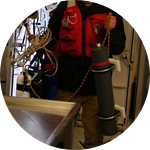About This Project
My goal with this project is to understand cooperation in foraging strategies of humpback whales in several different populations. I plan to study bubble-net feeding, a unique strategy of foraging that groups as small as one and large as 20 individuals participate in to maximize their energy gain. This project should increase our understanding of how humpback whales work together, and how they utilize their environment, so that we can minimize anthropogenic impacts in these areas.
Ask the Scientists
Join The DiscussionWhat is the context of this research?
Cooperation is seen in all different species of terrestrial birds and mammals, but has never been definitively shown in baleen whales. If funded, I will be able to investigate the nature of coordinated foraging in humpback whales in an effort to show that these species cooperate to maximize their feeding efficiency in multiple populations.
What is the significance of this project?
Humpbacks form large groups to forage on several different species of prey. They also have shown the capability for social learning in several foraging areas. Learning more about these whales and what drives the formation of different sized groups can provide evidence of the adaptability of these species to changing prey availability. It can also indicate the importance of social interactions to facilitate the learning needed to adapt to changing conditions.
What are the goals of the project?
The goals of this project are to acquire more data from a population of humpbacks in order to compare their foraging strategies and group interactions with other populations of humpbacks throughout the world.
Budget
I currently have limited data from humpbacks in Alaska. We lack the necessary data to complete a thorough analysis of their bubble-net feeding strategies. This data is essential for determining if bubble-net foraging is a cooperative behavior in Alaska and for comparing the feeding techniques between populations. If funded, I will be able to travel to Alaska and charter a vessel to tag at least three more bubble-net feeding whales. I currently have tagging equipment available for this project, so chartering a boat is the most important expense to tag feeding whales in this population.
Endorsed by
Meet the Team
Natalie Mastick
I grew up in Northern California, raised by a nurse practitioner and a landscape architect that instilled in me both a fascination for science and a love of nature at an early age. I have loved marine mammals since my first trips to the coast. I had little interest in captive animals beyond the excitement of seeing dolphins and killer whales up close; it was the way those marine mammals worked in their natural habitats that made me wonder and inspired me to ask questions.
I
never thought I would work with whales, but I have become particularly
fascinated humpback whales because they are so unique among normally
solitary baleen whales. Baleen whales are nothing like
other cetaceans--they don't form matrilineal groups,
Project Backers
- 41Backers
- 70%Funded
- $2,647Total Donations
- $64.56Average Donation


